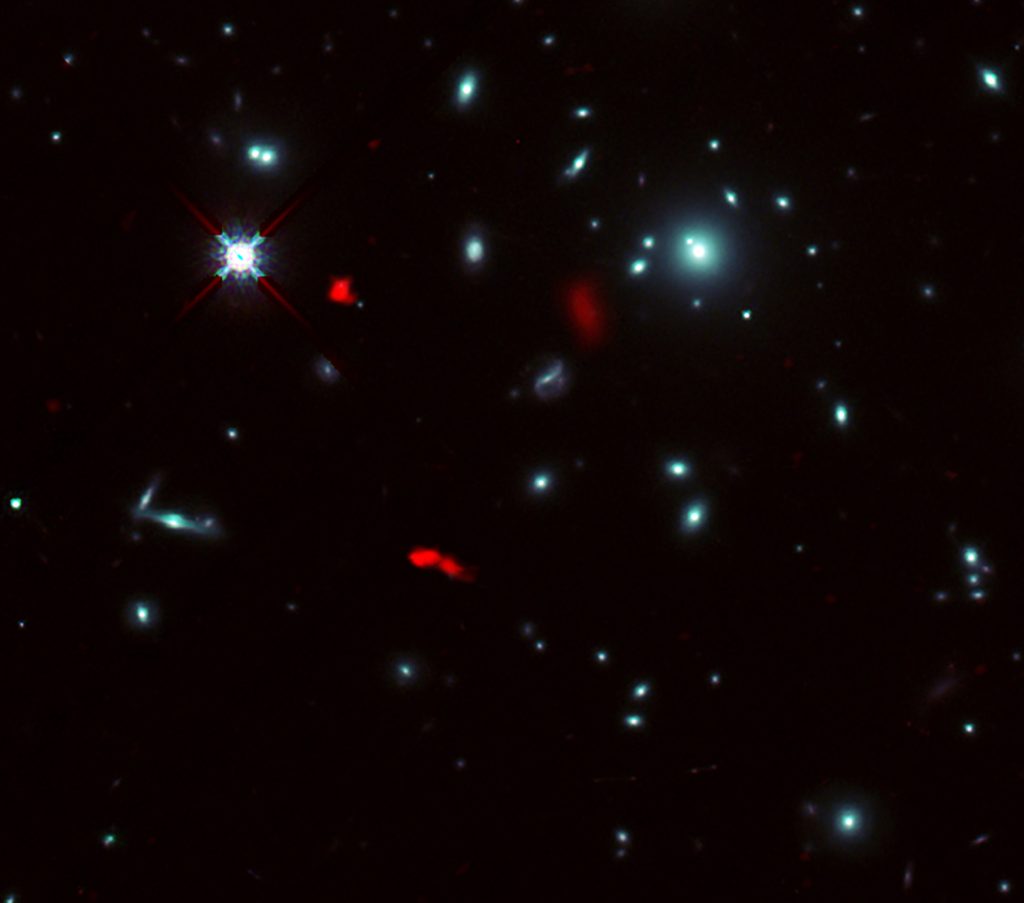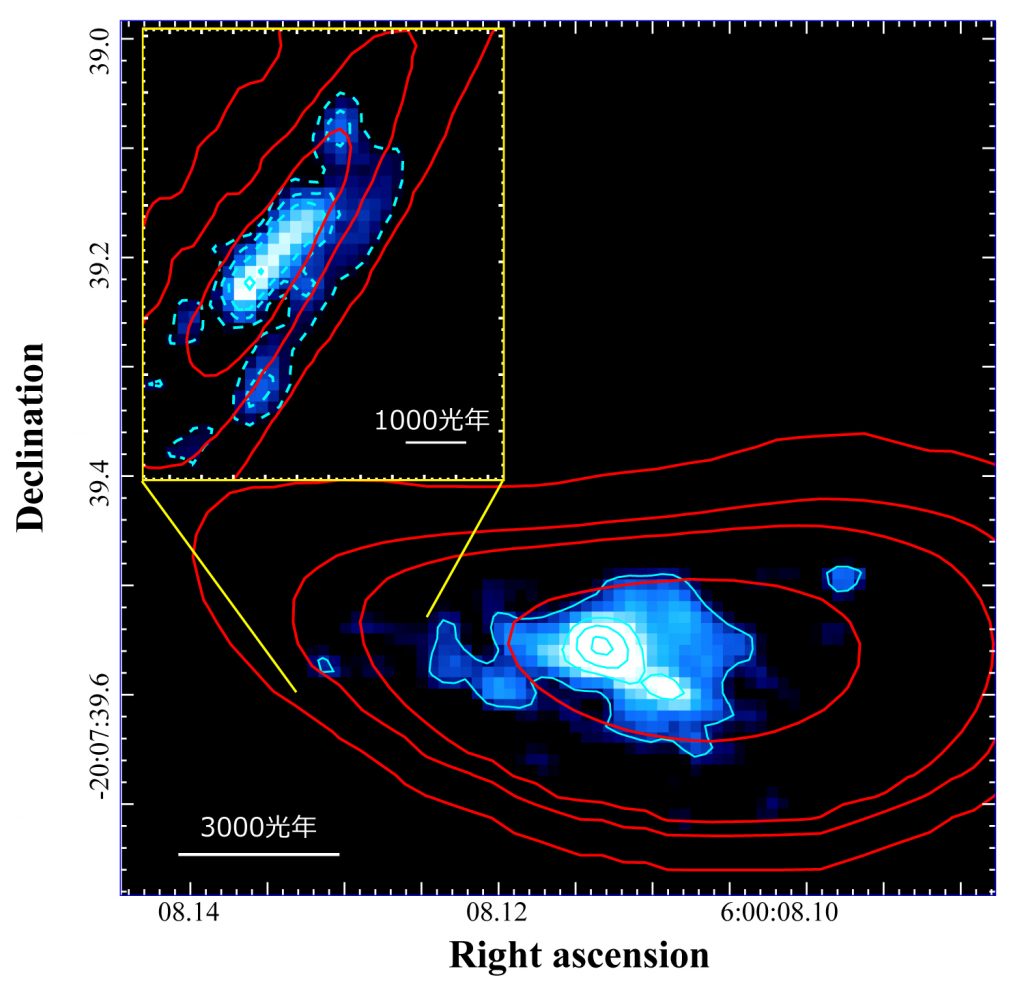National Astronomical Observatory of Japan
Institute for Cosmic Ray Research,UTokyo
School of Science,UTokyo
RIKEN
University of Cambridge
The Cosmic Dawn Center,The University of Copenhagen
Joint ALMA Observatory

Credit: ALMA (ESO/NAOJ/NRAO), Fujimoto et al., NASA/ESA Hubble Space Telescope
Summary
Using the Atacama Large Millimeter/submillimeter Array (ALMA), astronomers found a rotating baby galaxy 1/100th the size of the Milky Way at a time when the Universe was only seven percent of its present age. Thanks to assistance by the gravitational lens effect, the team was able to explore for the first time the nature of small and dark “normal galaxies” in the early Universe, representative of the main population of the first galaxies, which greatly advances our understanding of the initial phase of galaxy evolution.
Support
This research was supported by the Japan Society for the Promotion of Science KAKENHI (Grant Number JP17H06130, JP18K03693, 17H01114, 19H00697, and 20H00180), NAOJ ALMA Joint Scientific Research Program (2017-06B), European Research Council (ERC) Consolidator Grant funding scheme (project ConTExt, grant No. 648179, 681627-BUILDUP), ERC under the European Union’s Horizon 2020 research and innovation program (grant agreement No. 669253) , Independent Research Fund Denmark grant DFF-7014-00017, Danish National Research Foundation(No. 140), the Kavli Foundation, ANID grants CATA-Basal AFB-170002, FONDECYT Regular (1190818 and 1200495) , Millennium Science Initiative ICN12 009, STFC (ST/T000244/1) , NSFC grant 11933011, the Swedish Research Council, and the Knut and Alice Wallenberg Foundation. This work was partially supported by the joint research program of the Institute for Cosmic Ray Research (ICRR), University of Tokyo.
Contents
“Many of the galaxies that existed in the early Universe were so small that their brightness is well below the limit of the current largest telescopes on Earth and in Space, making difficult to study their properties and internal structure,” says Nicolas Laporte, a Kavli Senior Fellow at the University of Cambridge. “However, the light coming from the galaxy named RXCJ0600-z6, was highly magnified by gravitational lensing, making it an ideal target for studying the properties and structure of a typical baby galaxies.”
Gravitational lensing is a natural phenomenon in which light emitted from a distant object is bent by the gravity of a massive body such as a galaxy or a galaxy cluster located in the foreground. The name “gravitational lensing” is derived from the fact that the gravity of the massive object acts like a lens. When we look through a gravitational lens, the light of distant objects is intensified and their shapes are stretched. In other words, it is a “natural telescope” floating in space.
The ALMA Lensing Cluster Survey (ALCS) team used ALMA to search for a large number of galaxies in the early Universe that are enlarged by gravitational lensing. Combining the power of ALMA, with the help of the natural telescopes, the researchers are able to uncover and study fainter galaxies.
Why is it crucial to explore the faintest galaxies in the early Universe? Theory and simulations predict that the majority of galaxies formed few hundred millions years after the Big-Bang are small, and thus faint. Although several galaxies in the early Universe have been previously observed, those studied were limited to the most massive objects, and therefore the less representative galaxies, in the early Universe, because of telescopes capabilities. The only way to understand the standard formation of the first galaxies, and obtain a complete picture of galaxy formation, is to focus on the fainter and more numerous galaxies.
The ALCS team performed a large-scale observation program that took 95 hours, which is a very long time for ALMA observations, to observe the central regions of 33 galaxy clusters that could cause gravitational lensing. One of these clusters, called RXCJ0600-2007, is located in the direction of the constellation of Lepus, and has a mass 1000 trillion times that of the Sun. The team discovered a single distant galaxy that is being affected by the gravitational lens created by this natural telescope. ALMA detected the light from carbon ions and stardust in the galaxy and determined that the galaxy is seen as it was about 900 million years after the Big Bang (12.9 billion years ago) [1]. Further analysis of the ALMA and Gemini data suggested that a part of this source is seen 160 times brighter than it is intrinsically.
By precisely measuring the mass distribution of the cluster of galaxies, it is possible to “undo” the gravitational lensing effect and restore the original appearance of the magnified object. By combining data from Hubble Space Telescope and the European Southern Observatory’s Very Large Telescope with a theoretical model, the team succeeded in reconstructing the actual shape of the distant galaxy RXCJ0600-z6. The total mass of this galaxy is about 2 to 3 billion times that of the Sun, which is about 1/100th of the size of our own Milky Way Galaxy.

Credit: ALMA (ESO/NAOJ/NRAO), Fujimoto et al., NASA/ESA Hubble Space Telescope
What astonished the team is that RXCJ0600-z6 is rotating. Traditionally, gas in the young galaxies was thought to have random, chaotic motion. Only recently has ALMA discovered several rotating young galaxies that have challenged the traditional theoretical framework [2], but these were several orders of magnitude brighter (larger) than RXCJ0600-z6.
“Our study demonstrates, for the first time, that we can directly measure the internal motion of such faint (less massive) galaxies in the early Universe and compare it with the theoretical predictions”, says Kotaro Kohno, a professor at the University of Tokyo and the leader of the ALCS team. “The fact that RXCJ0600-z6 has a very high magnification factor also raises expectations for future research,” explains Seiji Fujimoto, a DAWN fellow at the Niels Bohr Institute. “This galaxy has been selected, among hundreds, to be observed by the James Webb Space Telescope (JWST), the next generation space telescope to be launched this autumn. Through joint observations using ALMA and JWST, we will unveil the properties of gas and stars in a baby galaxy and its internal motions. When the Thirty Meter Telescope and the Extremely Large Telescope are completed, they may be able to detect clusters of stars in the galaxy, and possibly even resolve individual stars. There is an example of gravitational lensing that has been used to observe a single star 9.5 billion light-years away, and this research has the potential to extend this to less than a billion years after the birth of the Universe.”
<Paper Information>
These observation results were presented in Seiji Fujimoto et al. “ALMA Lensing Cluster Survey: Bright [CII] 158 μm Lines from a Multiply Imaged Sub-L* Galaxy at z = 6.0719” in the Astrophysical Journal on April 22, 2021 (DOI: https://doi.org/10.3847/1538-4357/abd7ecs) and Nicolas Laporte et al. “ALMA Lensing Cluster Survey: a strongly lensed multiply imaged dusty system at z > 6” in the Monthly Notices of the Royal Astronomical Society on April 22, 2021.
Notice
[1] The light emitted from carbon ions was originally infrared light with a wavelength of 156 micrometers, but as the Universe expanded, the wavelength extended and became radio waves with a wavelength of 1.1 millimeters, which were detected with ALMA. The redshift of this object is z=6.07. Using the cosmological parameters measured with Planck (H0=67.3km/s/Mpc, Ωm=0.315, Λ=0.685: Planck 2013 Results), we can calculate the distance to the object to be 12.9 billion light-years. (Please refer to “Expressing the distance to remote objects” for the details.)
[2] Using gravitational lensing, ALMA discovered a rotating galaxy similar in size to the Milky Way at about 12.4 billion years ago. (Please refer to the news article “ALMA sees most distant Milky Way look-alike” issued on August 13, 2020). Also, ALMA discovered a rotating galaxy from 12.4 billion years ago without using gravitational lensing. (Please refer to the news article “ALMA Discovers Massive Rotating Disk in Early Universe.”)
The Atacama Large Millimeter/submillimeter Array (ALMA), an international astronomy facility, is a partnership of the European Organization for Astronomical Research in the Southern Hemisphere (ESO), the U.S. National Science Foundation (NSF) and the National Institutes of Natural Sciences (NINS) of Japan in cooperation with the Republic of Chile. ALMA is funded by ESO on behalf of its Member States, by NSF in cooperation with the National Research Council of Canada (NRC) and the Ministry of Science and Technology (MOST) and by NINS in cooperation with the Academia Sinica (AS) in Taiwan and the Korea Astronomy and Space Science Institute (KASI). ALMA construction and operations are led by ESO on behalf of its Member States; by the National Radio Astronomy Observatory (NRAO), managed by Associated Universities, Inc. (AUI), on behalf of North America; and by the National Astronomical Observatory of Japan (NAOJ) on behalf of East Asia. The Joint ALMA Observatory (JAO) provides the unified leadership and management of the construction, commissioning and operation of ALMA.
This research result has been jointly released to the press by National Astronomical Observatory of Japan, RIKEN, Institute for Cosmic Ray Research, UTokyo, School of Science, UTokyo, University of Cambridge, The Cosmic Dawn Center,The University of Copenhagen and Joint ALMA Observatory.





